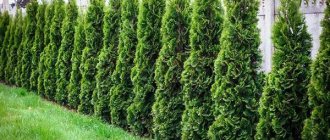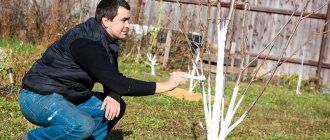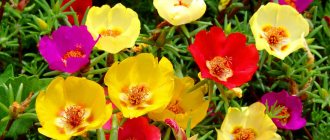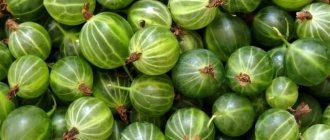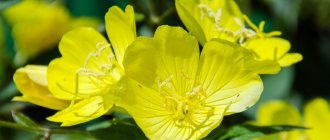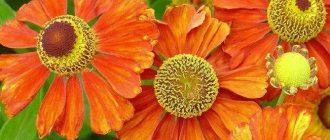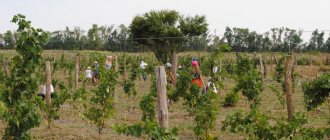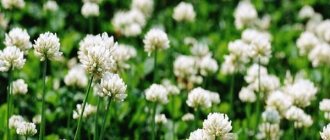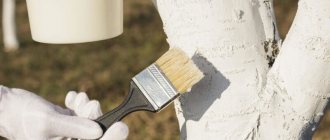When are seedlings planted?
In addition to the question of how to plant fruit trees correctly, it is important to maintain planting deadlines. Experts recommend planting seedlings in the fall, but this applies primarily to the southern regions.
During the warm and long autumn, trees and shrubs that are resistant to cold have time to undergo the process of acclimatization and rooting. They tolerate winter well, and in early spring the seedlings begin to actively grow.
However, trees in the northern regions run the risk of not surviving until spring and of freezing. This is the reason why it is better to plant fruit trees in the northern regions in the spring. It is necessary to carry out such planting early so that the growing season of the seedling begins at the moment when it is already in the soil.
As part of the spring sales, you can acquire seedlings with blossoming buds and even leaves. Such plants can no longer wait; they should be planted as quickly as possible. However, it is best to plant when warm weather stabilizes, when you don’t have to worry about the shoots or root system freezing. It is recommended to plant in cloudy weather, when the risk of sunburn of the foliage is not so great.
It is impossible to establish clear timing for planting fruit tree seedlings. Here it is necessary to take into account the climatic and weather characteristics of the region, soil composition and location of the site.
Whenever it is planned to plant seedlings, preparatory work should begin in the autumn: you need to decide in advance on the location on the site and prepare holes for planting.
Purchasing seedlings
The first thing you need to start with is to buy a young tree for planting. There are different options where this can be done. It would be best if you go to make a purchase at a specialized store or nursery.
In addition, there are many offers to buy seedlings from hand at spontaneous markets, and also, not so long ago, online stores began to provide a huge selection of planting material. The last two options do not provide any guarantee of quality, so there is a risk of not getting what you expect.
Conditions for planting fruit trees
Fruit seedlings should be planted at air temperatures above 0 °C, in which case the plant takes root better. It will take approximately 2–2.5 months for the plant to adapt to a new location.
There are situations when seedlings that were planted in the fall and survived the winter safely die from excess moisture before they have time to grow stronger. This happens when melt and rain waters stand for a long time, making it difficult for oxygen to reach the root system. This problem is typical mainly for clay soils. These facts indicate that such trees should be planted in the spring. But trees need to be replanted in a dormant state, when the foliage has already been shed.
Mini trees in pots in the garden
To plant plants in pots, you need to choose shade-loving trees that can develop regardless of environmental conditions. It is advisable to adhere to the following rules:
- the pot should easily accommodate the root;
- at the bottom of the container you need to make several holes to remove excess moisture;
- it is preferable to choose a wooden version of the material for the container so that the soil does not stagnate;
- It is better to choose the south side of the site for placement.

Trees in pots
Note! In some situations, open ground is better than a pot, since many varieties have an overly branched root system.
Rules for planting fruit seedlings on the site
There is a lot of controversy about how to properly plant fruit tree seedlings in the spring. Step-by-step recommendations will tell you how to do it correctly.
- We are preparing the ground. The area must first be cleared of weeds. This can be done mechanically or by resorting to folk remedies for weeds. It is also necessary to do pre-planting cultivation: plow the soil deeply and fill it with organic fertilizers.
- Planting hole. When planning planting work in early spring, you need to prepare the holes in the fall. For each seedling, a square hole is dug (depth 50–70 cm, sides 1–1.5 m). This recess is filled with cut branches, tops, compost, etc. All that remains is to pour soil on top and leave it until spring to rot. If the planting of seedlings is planned for the spring-summer period, the holes can be prepared a month in advance. Crushed stone, broken brick, and coarse river sand are laid in layers at the bottom. After this, rotted manure and peat are placed in the hole. On top of this mass, laid in layers, there is soil mixed with humus, no thicker than 5–10 cm. It is poured in a cone shape. The walls of the pit cannot be smoothed with a shovel, since if the soil is compacted, this will impede the movement of air, which will negatively affect the root system.
- We plant fruit trees in prepared soil. It is important to know how to plant trees correctly. After the soil settles, you need to drive a stable wooden stake into the central part of the hole. Thanks to such a support, the wind will not be able to swing and damage the young seedling. In addition, no voids are formed between the soil and the roots.
A day before planting, broken branches and roots should be removed from prepared plants. Planting rules involve planting a tree in such a way that the root collar of the plant exceeds the soil level. If you plant deeper, the bark begins to rot and the seedling dies. The root collar is the boundary along which the tree bark is divided into two parts, each of a different color: greenish and milky brown.
When planting, you need to pay special attention to the base of the trunk, which should rest against the top of the cone made of earth. The roots must be carefully spread along the slope and sprinkled with soil. In this case, you need to focus on the root collar, which should be 5–6 cm above the ground.
If you sprinkle black soil on top, then the seedling should be shaken slightly. This is done so that the empty areas between the roots are filled with soil. If this is not done, the roots are in danger of drying out. Around the trunk, the earth is lightly compacted with a foot and watered. Each seedling should contain 3 buckets of liquid. After this, you need to wait until the soil settles, then water and compact again.
What fertilizers should be applied to planting holes?
Planting holes for fruit trees and berry bushes, as we have already found out, need to be prepared a month before planting the seedlings (or even earlier) so that the soil has time to mature. And it is necessary to apply fertilizers there. But which ones?
For fruit pome crops: apple, pear, quince
When planting apple, pear, and quince trees, be sure to add superphosphate. It’s better to double – 200 g for each seedling. And always in combination with organic matter - 2 buckets of rotted manure, humus or leaf compost (fresh manure and chicken droppings cannot be used!). Here you need to add 700–1000 g of wood ash.
Fertilizers are mixed with the fertile top layer of soil and the planting hole is filled with this mixture.
Such a nutritious “cocktail” will provide fruit trees with phosphorus nutrition (very important for young trees!) for the first 5–7 years. After planting, it will no longer be possible to apply these fertilizers to the root growth zone.
Phosphorus is almost never washed out of the ground, and these reserves will nourish your trees for a long time. So don’t be lazy – the extra hour spent on boarding will definitely meet your expectations!
For stone fruit trees: plum, cherry plum, apricot, cherry, peach
These include plum, cherry plum, apricot, peach, cherry and sweet cherry. For these crops, 1.5 buckets of humus or compost, 100 g of double superphosphate and 700–1000 g of wood ash are added to each pit.
For berry bushes: currants, gooseberries, raspberries
For currants, gooseberries and raspberries, add 1 bucket of humus or compost, 1 tbsp. l. double superphosphate and a 700-gram jar of ash.
For grapes
Holes for grapes are dug according to the same principle as for fruit trees - the soil is traditionally thrown in two directions: fertile soil separately, clay separately. The bottom of the pit is loosened with a pitchfork, after which 200 g of superphosphate and 90 g of potassium sulfate (potassium sulfate) are added. Fertilizers are evenly distributed along the bottom of the pit, then 1 bucket of fertile soil is poured in and everything is thoroughly mixed.
You can add 1-2 buckets of humus or compost to the hole. But if you are not sure that the manure has been well rotted, it is better not to risk it. Fresh manure, when rotted at depth, releases substances that inhibit the growth of roots, and can even cause their death if the “burning” process begins.
The soil with fertilizers is slightly compacted, 1-2 buckets of soil from the “fertile” pile are added. The pit is ready for planting.
After such refueling, the seedlings do not need to be fertilized for 3 years.
For garden strawberries
Strawberries grow best in light to medium soils with an acidity pH of 5.0–6.5. When preparing the soil, 5–6 kg of organic fertilizers and up to 40 g/m² of mineral fertilizers (20 g of superphosphate and 100 g of wood ash) are applied per 1 m². Then a deep excavation of the site is carried out.
Planting begins after the prepared soil has settled. The area should be well leveled, without ridges or depressions.
Mineral nitrogen fertilizers cannot be applied to planting holes - they can burn the roots!
How to care for trees after planting
It is important not only to know how to plant fruit tree seedlings in the spring, but also to provide proper care for young trees. They need to be given special attention in the first two years of life. It is necessary to take care of moderate regular watering and fertilizing, ensure loosening, and get rid of weeds. During the dry period, the soil around the planted trees must be thoroughly loosened periodically.
Don’t forget about mulching the tree trunks. The role of rotting mulch is difficult to overestimate:
- is a guarantor of excellent aeration of the rhizome;
- helps combat the problem of soil drying out;
- blocks weed germination;
- prevents soil freezing in the winter months;
- young plants receive the necessary organic nutritional components;
- reduces the risk of soil crust formation.
However, remember that soils that are overly moistened do not need to be mulched.
After care
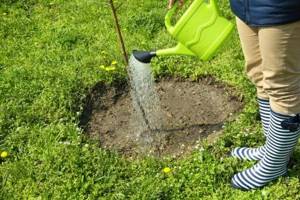
Immediately after the tree is planted, it is necessary to water it at the root. The water pressure should not be too strong so as not to erode the soil, so use a watering can with a socket or a hose with a sprinkler nozzle.
After filling the "pool", wait until the water is absorbed, then fill it again. For the first watering you will need 1-2 buckets of water.
In the first year after planting, seedlings are watered quite often - as the soil dries out (during drought - 1-2 times a day). Then the frequency of watering is gradually reduced, and completely stopped for 2-3 years.
Experienced gardeners recommend mulching the tree trunk circle - pour a layer (8-10 cm) of mulching material (wood chips, sawdust, mown grass, etc.), leaving the root collar uncovered. This will improve the soil structure and protect it from freezing.
During the first year of a planted tree’s life, it is necessary to monitor how it develops and, if possible, correct deficiencies. There is no need to feed the seedling in the first year, since all the basic fertilizers were applied during planting. The tree trunk circle should be loose and free of weeds.
Carefully inspect the young tree and collect leaf-eating caterpillars, which can cause great harm to the plant. Also, do not allow growth to form on the trunk and near the roots; if necessary, cut it off at the very base.
The tree should not be tightly tied to the peg; check that the garter material does not rub the bark of the seedling or cut into it. If damage is visible, loosen the garter.
Features of planting apple tree seedlings
A number of apple varieties (early ripening) are capable of producing color in the first spring. However, they are not yet fully developed, so you can’t count on harvesting a full harvest in the fall. When planting fruit trees, it is recommended to pick off the flowers before they bloom. This measure is necessary for the plant to take root well. If the apple tree develops without deviations, then next year it will be possible to leave a dozen or two flowers on the branches.
Such varieties of apple trees as “Antonovka vulgaris”, “Grushovka Moskovskaya”, “Summer Striped”, “Dessert Isaeva”, “Lingonberry” are easily adaptable.
Orchard layout
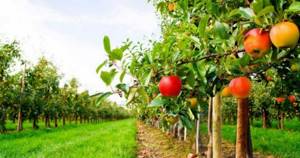
Before planting fruit trees on your site, you need to think everything through. An orchard is planted with a perspective of several decades, and not only its yield, but also the health of all the trees depends on the correct layout. The process includes several tasks:
- Determining a place to plant trees. The best location for an orchard is the south side of the garden plot, free from high fences, foreign buildings, and old trees.
- Site preparation includes clearing the area of debris and stones, uprooting stumps, and plowing the ground.
- It is advisable to do a soil analysis in a chemical laboratory before planting a fruit garden. If necessary, the soil should be fertilized; you can add minerals that are lacking in the soil directly into the holes for planting trees.
Types of layout
After the preparatory work has been completed, you can begin the important task of choosing a fruit tree planting scheme. Trees will be illuminated by the sun most of the day if the rows are located from north to south
It is rational to plant low-growing plants on the outside of the garden, and tall trees on the inside. Fruit crops cannot be planted together with decorative ones; it is better to place the latter around the perimeter of the site. There are several types of garden layout:
- Quadratic - with this scheme, trees are planted in a pre-marked square, in strict rows.
- Planting an orchard with a checkerboard pattern is similar to a quadratic one, but in this pattern the trees in each subsequent row are planted offset. It is best to use this scheme on slopes to prevent soil from being washed away by precipitation.
- A triangular planting pattern is used if it is necessary to plant a large number of trees; the distance between rows and plants depends on their height and crown size.
- Planting an orchard in a horizontal pattern is often used in hilly areas. Marking rows in straight lines allows trees to be planted so that they receive the maximum amount of sunlight and do not interfere with each other.
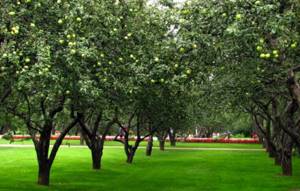
Tree selection
In order to get a rich fruit harvest, it is important to choose the right fruit trees for your garden. The region in which you plan to plant a garden is of great importance
Depending on the average temperature, soil type, and weather conditions, you should choose certain plant varieties. A list of the best fruit trees that you should definitely plant in your garden is presented below.
- The apple tree
is a light-loving crop that grows well in high areas. It is not picky about the type of soil, but does not tolerate excess moisture. - The pear
does not withstand severe frosts; it prefers southern areas, well protected from cold winds. Moist soils work well for pears. - Cherry
is a heat-loving tree; it cannot be planted in cold climate zones with harsh winters. - Plum
is a crop that loves light and warm areas. If you wish, you can try planting a plum in the northern regions; with proper care, it will delight you with a harvest.
Planning errors
You can avoid mistakes when planting an orchard and achieve a rich harvest by listening to the advice of experienced gardeners.
Before planting, it is necessary to calculate the number of trees, which are best selected so that they bear fruit at different times, some in summer, others in autumn. When planning the planting of fruit trees, special attention should be paid to selecting plants according to height, calculating which planting scheme is best to use so that the trees do not interfere with each other. It is a mistake to plant stone fruit and pome trees together; for ease of care, it is better to place them in separate groups.
How to plant a pear
The vast majority of pear varieties do not require any special care or soil composition. However, pear seedlings adapt and grow much better on humus-rich soils, loose soils, and well-lit areas. Drought is contraindicated for young plants. In the first years of planting fruit seedlings, it is necessary to provide abundant and frequent watering. The pear tree begins to bear fruit at the age of 3–8 years.
Active hybridization of species has led to the fact that a fairly diverse number of unusual species have now been bred. Among the most popular varieties, it is worth noting such as “Lada”, “Nectarnaya”, “Cathedral”, “Allegro”, “Dibrovskaya”.
How to plant a seedling correctly?
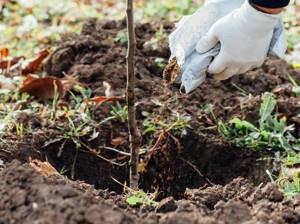
When digging, place the top (turf, 15-20 cm deep) layer on one side of the hole, and the bottom layer (it has a darker color) on the other side. Make the pit round and the walls vertical (steep).
Stick a strong stake 1.5-2 m long into the bottom of the hole in the center so that you can later tie a seedling to it. Place the dug layer of turf at the bottom, then fill the hole with part of the fertile substrate to a height of 15-20 cm (mix equal amounts of peat, compost and soil removed from the hole).
Form a mound at the bottom of the hole and place the seedling in it (close to the stake), evenly distributing the roots.
Make sure that when planting, the roots of the seedling do not bend upward: bent roots develop worse and “slow down” the tree’s establishment.
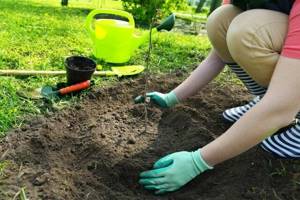
When installing a seedling in a hole, bury it in the soil strictly up to the root collar; ideally, it should be located 3-5 cm above ground level. Later, the soil will settle a little and the root collar will descend.
If the seedling is buried too deep, the plant may begin to rot in the future. While holding the seedling (you will need someone's help for this), fill the hole with the remaining substrate.
The root collar is the place where the plant trunk meets the roots. Usually it is 2-3 above the topmost root.
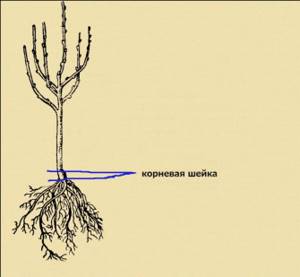
Gradually compact the soil with your feet, pressing on it from the edge to the center of the tree trunk circle. Tie the trunk of the seedling not very tightly to the stake in two places, so that when the soil “shrinks,” the tree also sinks.
Form a roller around the tree along the perimeter of the circle (you will get a watering “pool”).
Cherry planting
If you know how to plant cherries correctly, you will be able to ensure their rich fruiting. Special attention should be given to the place where the tree will be planted. If you choose it incorrectly, you will not be able to wait for a good harvest. The cherry root system is located close to the surface, so the plant is sensitive to drought. Loosening after watering should be done extremely carefully.
Among the most common varieties are the following: “Octave”, “Crimson”, “Vole”, “Prima”, “Robin”, “Youth”.
Planting fruit tree seedlings must be done in accordance with certain rules. Only in this case can you count on getting a good harvest.
Source


